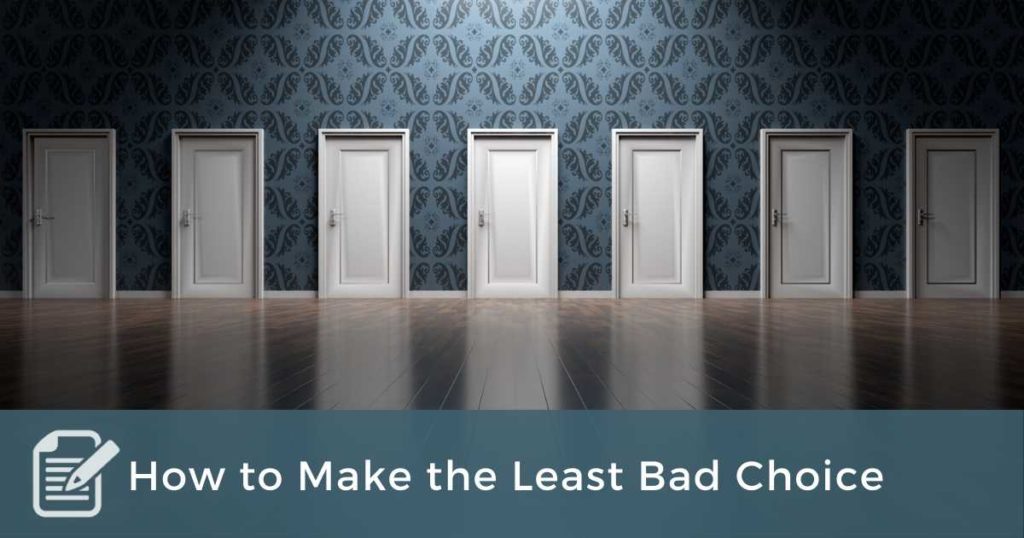Where I am coming to, because of the threat of ISIS, … maybe we have to make a bad choice… a least bad choice…. – Author Thomas Friedman on Charlie Rose
Friedman was talking about the options the next American President will have in the Middle East. There isn’t a good option, but the next President will have to pick one anyway.
There are lots of “least bad choices” people need to make.
- Surgery or radiation
- Put up with incompetence or fire your brother
- Voting in the upcoming American Presidential election
- Lay people off or cut salaries
- Work a job I hate or make less money
How do we help prepare someone to make the least bad choice?
Extend a Safe Presence
As a coach, make clear to the client that these choices are accompanied by pain and consequence and that we are extremely grateful that there are capable people willing to make these tough choices. Hold your own opinions even closer than usual. This is a tough decision, and it isn’t yours. You could cause more harm than good by influencing the decision maker. The client will have plenty of people with an opinion, but they may have only you to be neutral and allow them a safe space to think.
Promise confidentiality. We can’t overstate this. A recent new client’s first question to me was “Is this confidential?” When a client is trying to figure out a least bad choice, they will have to explore some nasty possibilities. To be able to talk about some of these avenues out loud will be difficult. The client needs you to be a vault of private information.
When the conversation is over, don’t forget that the safe presence is also over. The client will remember and appreciate that you created a safe space but don’t get the idea that you now have a permanent safe space with this person outside of the coaching relationship. You don’t. Treat the client like the conversation never happened. Don’t give them a knowing look. Don’t ask how it turned out. Don’t give anyone the impression that you were part of the decision process.
Weigh the Full Consequence
As a coach, I like to be positive and encouraging, but we aren’t doing our client any favor by ignoring the full consequences of each action. The two of you must explore the positives and the negatives of each choice both for today and for the future. One choice may be the best short-term choice. Another choice may be the best long-term choice. You need to help your client see long-term, especially when the choices are so bad. If they are going to have to make an unpopular decision, they have the opportunity to make a long-term decision that could fix a lot of the problems that a short-term decision won’t fix.
We really need to check ourselves as coaches that we are not unconsciously creating a favored order to the choices. The client needs every choice on the table, and they must do the sorting. I must admit when a client has an exciting option on the table, I have caught myself trying to steer them toward the bold choice. But I need to remind myself that I am not the expert of their life.
Explore the consequences of each choice. Leave no stone unturned. They hired a coach to help them think deeper not to make the choice for them.
Feel the Emotion
Decisions like these don’t come separated from the accompanying emotion. These choices will affect people we love, people we represent, people who expect to be protected. Your client won’t just have to live with the consequences of the decision, they will have to live with the emotions of the decision. The idea that decisions should be made in the cold with no consideration for how it makes me feel is an outdated idea.
Let’s say your client makes their decision without considering their heart. They made a cold, calculated decision, but they made that decision in the safety of your presence. Now, they go out and have to literally make this decision all over again when they announce it. Their heart will show up at that time. If you haven’t helped your client consider how their heart will show up, you will leave them unprepared.
Your client isn’t just going to need to consider how they feel about the decision; they need to consider how others will feel about the decision so that they will know how to lead them well. What else can the client put in place that will help others embrace this as their own least bad choice.
Don’t hear this wrong. Feelings shouldn’t dictate decisions, but feelings shouldn’t be left out of the discussions either. The client may need an action step in order to know how to cope with the impending emotion.
Plan Small Steps
This may be counter-intuitive depending on how big the decision is, but make sure at least a few of the action steps are really small. Make a least bad choice feels like jumping out of a perfectly good airplane. Their heart will be thumping, their skin will be sweating, their mouth will be sticky. They may need an action step of who they will tell first. They may need an action step to pray. Laying out small action steps will give the client firmer ground when the moment comes.
I recently performed a funeral for a woman whose husband adored her. He relied on her. She left him a note to read at her passing. One thing the note explained was exactly what to wear to her funeral. This was a real gift to him because in his immense grief, this small choice seemed difficult. By creating a set of very small action steps, you help the client to stay focused on the tough choice that needs to be made.
Conclusion
We need good people to make least bad decisions more than ever. As a coach, we can help our client see that they aren’t the cause of the problem. They are the person that God has called to clean up the mess.
I want to end with the words of Bill Bratton, Police Commissioner of New York City. Interviewer Charlie Rose was asking him about the recent police shootings. These kind of problems seem almost impossible to solve. No matter what choice you make it could make the situation worse. Charlie Rose asked Bratton if he was optimistic.
My wife will tell you I’m the most optimistic person in America. I get up every morning and just say “What a beautiful day.” I like challenge and I see crises as an opportunity to address challenges. — William Bratton, New York City Police Commissioner, on Charlie Rose
Help your clients know that God has put them in their position for a time such as this, to rise to the challenge and to address the crisis at hand.




2 thoughts on “How to Make the Least Bad Choice”
Brilliant piece. Thank you!
I really appreciated this article. It is particularly meaningful and helpful as we look around at so many hard choices people are facing. In particular, the reminder to consider emotions, look for small steps and remain neutral were very helpful.